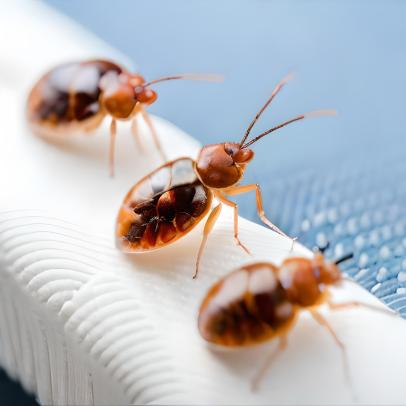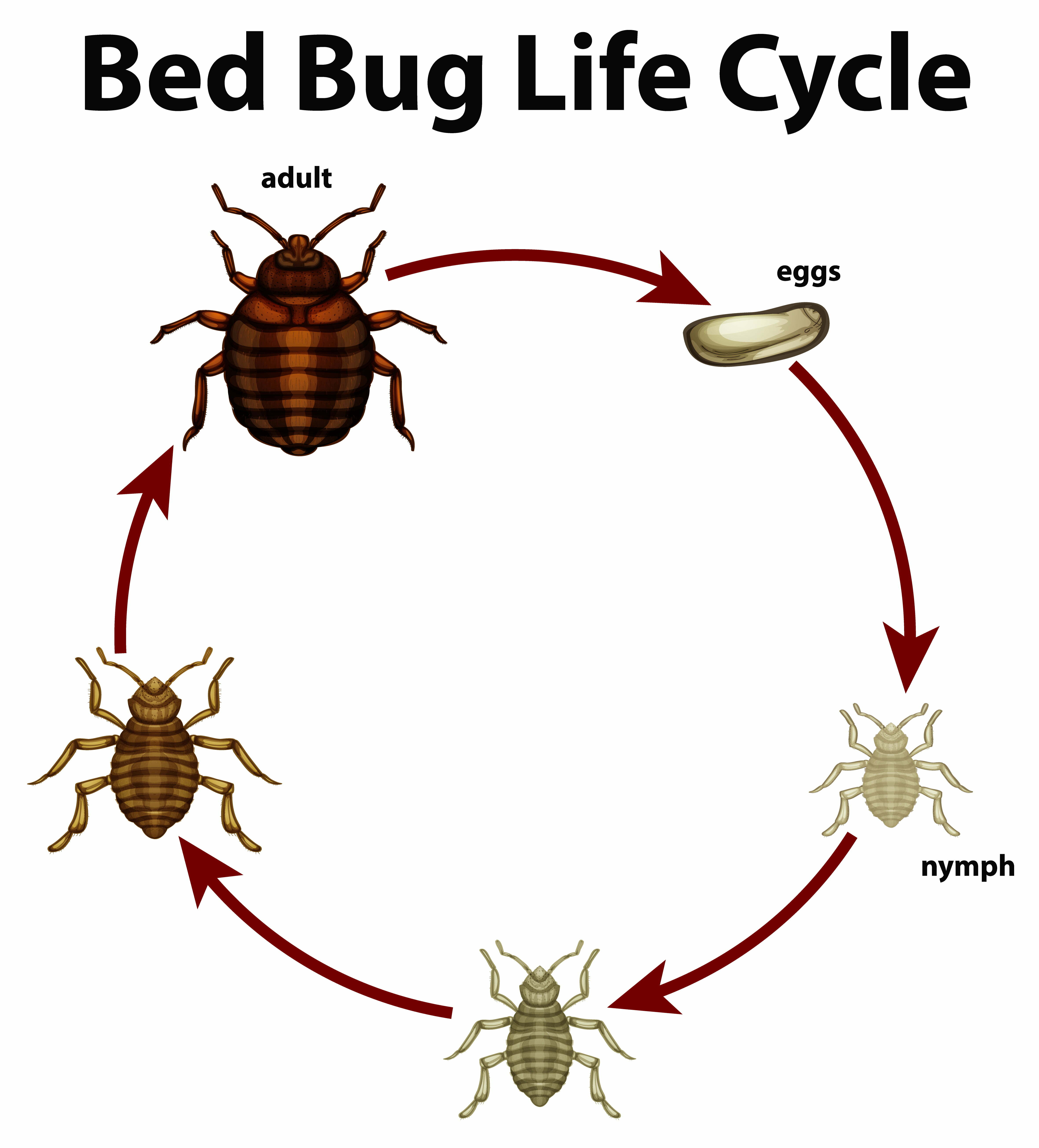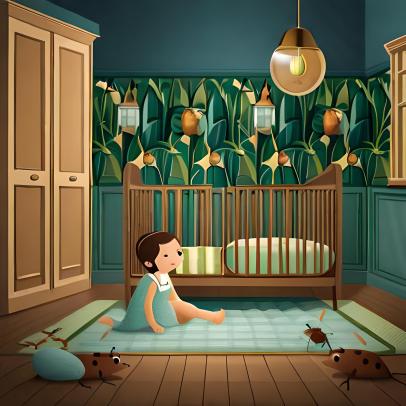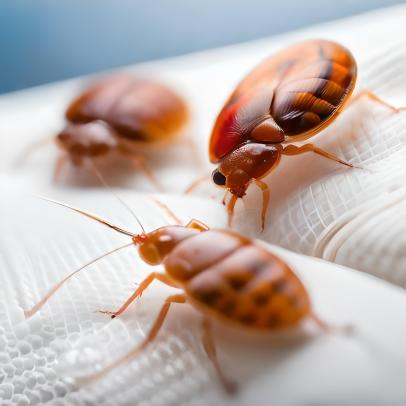Comprehensive Guide to Dealing with Baby Bed Bugs

In this comprehensive guide, we will provide you with all the necessary information and effective strategies to combat the menace of baby bed bugs. Our expert insights and practical tips will equip you with the knowledge to eradicate these pests from your home and prevent future infestations. With a focus on detailed preventive measures, identification techniques, and treatment options, we aim to offer you the best resources to address this common household issue effectively.
What are Baby Bed Bugs?
Baby bed bugs, also known as nymphs, are the immature stages of bed bugs (scientifically known as Cimex lectularius). Bed bugs are small, parasitic insects that feed on the blood of humans and animals.
When bed bug eggs hatch, they release nymphs, which are miniature versions of adult bed bugs. Nymphs are typically translucent or light tan in color and range in size from 1.5 millimeters to 4-5 millimeters, depending on their growth stage.
Bed bug nymphs require a blood meal to molt and progress to the next stage of development. They undergo several molts, shedding their exoskeletons each time, before reaching adulthood. During each molt, nymphs increase in size and become darker in color.
Baby bed bugs have similar characteristics to adult bed bugs, including a flat, oval-shaped body and a reddish-brown color after feeding. However, nymphs are generally lighter in color and may appear more translucent before their first blood meal. They also lack the fully developed wings of adult bed bugs.
It's important to note that baby bed bug bites are just as capable of biting and feeding on humans as adult bed bugs. They can cause itchy, red bite marks and nuisance in infested areas. Proper identification and prompt treatment are essential to control and eliminate bed bug infestations.
What do Baby Bed Bugs Look Like
Baby bed bugs, also known as nymphs, have a slightly different appearance compared to adult bed bugs. Here is a description of what baby bed bugs look like:
Size: Baby bed bugs are generally smaller in size compared to adults. They typically measure about 1 to 4 millimeters in length, depending on their stage of development.
Color: When baby bed bugs hatch, they are translucent or whitish-yellow in color. As they feed and grow, their color changes to a reddish-brown or rust-like hue.
Shape: Baby bed bugs have a similar body shape to adult bed bugs. They have an oval-shaped body with six legs and a segmented abdomen.
Features: Like adult bed bugs, nymphs have a flat body, which allows them to hide in tight spaces such as mattress seams, cracks, and crevices. They also have a small, round head and a pair of antennae.
Eggs: Before hatching, baby bed bugs are in the egg stage. Bed bug eggs are tiny and pearl-white in color. They are about 1 millimeter in length and can be found in clusters or individually.
It's worth noting that baby bed bugs go through several molting stages, shedding their exoskeletons as they grow. As they mature, they become darker in color and develop more distinct features, resembling adult bed bugs more closely.
Life Cycle of Baby Bed Bugs

Image by brgfx on Freepik
The life cycle of baby bed bugs, also known as nymphs, goes through several stages before reaching adulthood. Here's a breakdown of the life cycle:
Eggs: Female bed bugs lay small, white eggs in batches of about 1 to 5 eggs per day. These eggs are approximately 1mm in size and are often deposited in hidden crevices or cracks near the bed bug's preferred hiding spots.
Nymph Stage 1: After around 1 to 2 weeks, the eggs hatch, and the baby bed bugs emerge as nymphs. At this stage, the nymphs are translucent and only about 1.5mm in size. They immediately start searching for a blood meal to feed on.
Nymph Stages 2 to 5: As the nymphs feed on blood, they grow larger and molt (shed their exoskeleton) between each stage. Molting is necessary for their growth. With each molt, the nymphs become darker in color and their exoskeleton hardens. These nymphal stages usually last for about 4 to 5 weeks, but the duration can vary depending on factors like temperature and food availability.
Adult Stage: Once the nymphs reach the fifth and final nymphal stage, they have grown into adult bed bugs. At this point, they are approximately the size of an apple seed, around 4 to 5mm in length. Adult bed bugs are brownish-red in color and have a flattened oval-shaped body. They are capable of reproducing and can live for several months to a year or more, depending on environmental conditions.
It's important to note that bed bugs require a blood meal between each nymphal stage, and they prefer to feed on human blood. They are attracted to body heat and the carbon dioxide we exhale, which is why they tend to infest areas near sleeping or resting places.
Proper identification and effective treatment methods are crucial in dealing with a bed bug infestation, as they can reproduce rapidly and cause significant discomfort and annoyance. Consulting with a professional pest control service is often recommended for effective eradication.
Preventing Baby Bed Bug Infestations

To prevent baby bed bug infestations, also known as nymphs, you need to take proactive measures to eliminate adult bed bugs and prevent their reproduction. Here are some steps you can take:
Identify and treat the infestation: Thoroughly inspect your bedding, mattress, box springs, and nearby furniture for signs of adult bed bugs, such as live bugs, shed skins, or dark spots of excrement. If you find any signs, it is essential to treat the infestation immediately. Consult a professional pest control service for effective treatment options.
Encase your mattress and box spring: Use bed bug-proof encasements on your mattress and box spring to prevent bed bugs from entering or escaping. These encasements are specially designed with tight zippers and strong fabric to trap any existing bugs and prevent new ones from infesting your bedding.
Vacuum regularly: Vacuum your mattress, bed frame, furniture, and other infested areas regularly. Focus on seams, crevices, and cracks where bed bugs may hide. Immediately empty the vacuum bag or dispose of the contents in a sealed plastic bag to prevent bed bugs from escaping.
Wash and heat-dry bedding: Wash your bedding, including sheets, pillowcases, blankets, and bed covers, in hot water. Use the highest heat setting on your dryer to kill any bed bugs or eggs that may be present. Make sure to dry the bedding thoroughly.
Reduce clutter: Clutter provides hiding places for bed bugs, making it harder to eliminate them. Minimize clutter in your bedroom and other infested areas. Remove unnecessary items, such as old newspapers, magazines, or clothing, and keep your living space tidy.
Seal cracks and crevices: Use caulk to seal any cracks or crevices in walls, baseboards, and furniture. Bed bugs can hide in these tiny spaces, so sealing them off will help prevent infestations.
Be cautious when traveling: When staying in hotels or other accommodations, inspect the mattress, headboard, and nearby furniture for signs of bed bugs before settling in. Keep your luggage elevated and away from the bed, preferably on a luggage rack or in the bathroom.
Avoid bringing used furniture into your home: Secondhand furniture can be a common source of bed bugs. If you must bring used furniture into your home, carefully inspect it for signs of infestation and consider treating it before bringing it indoors.
Regularly inspect and treat pets' bedding: Bed bugs can infest your pets' bedding and travel to other areas of your home. Inspect and clean your pets' bedding regularly, and consult a veterinarian for appropriate treatment options if necessary.
Monitor for signs of infestation: Stay vigilant for any signs of bed bugs, such as bites on your skin or small blood stains on your bedding. Early detection can help prevent a full-blown infestation.
If you suspect a baby bed bug infestation or are unsure about the extent of an infestation, it is recommended to seek professional assistance from a pest control expert who can provide effective treatment and guidance.
Identifying Baby Bed Bugs

Baby bed bugs, also known as nymphs, are the immature stages of bed bugs. They are smaller in size compared to adult bed bugs and have a lighter coloration. Here are some characteristics that can help you identify baby bed bugs:
Size: Baby bed bugs are tiny and can range from 1.5 to 4.5 mm in length, depending on their age and feeding status. They are generally smaller than a grain of rice.
Color: Nymphs are lighter in color compared to adult bed bugs. They are translucent or whitish-yellow when they haven't fed, and their color darkens to reddish-brown after a blood meal.
Shape: Like adult bed bugs, baby bed bugs have an oval-shaped body. However, their bodies are more elongated and narrow compared to fully grown bed bugs.
Lack of wings: Nymphs do not have wings. The wing pads, which will develop into wings in adult bed bugs, may be visible as small, non-functional bumps on the sides of their bodies.
Nymphal stages: Baby bed bugs go through five nymphal stages, called instars, before reaching adulthood. As they grow, they shed their exoskeletons (molting) and leave behind empty translucent skins. You might find these discarded skins near their hiding spots.
Behavior: Nymphs, like adult bed bugs, are nocturnal and prefer to feed on blood during the night. They hide in cracks, crevices, and other secluded areas near their food source (usually a human host) when they are not actively feeding.
It's important to note that bed bugs, regardless of their life stage, are usually found in clusters or groups. If you suspect a bed bug infestation, it's recommended to seek professional pest control assistance for proper identification and effective treatment.
DIY Treatments for Baby Bed Bugs Infestations

Discover effective DIY treatments to eliminate baby bed bug infestations in your home.
When dealing with a baby bed bug infestation, there are several effective do-it-yourself treatments you can try. These methods can help control and eliminate these pests without the need for professional assistance. However, it's important to note that severe infestations may still require the intervention of a pest control professional. Here are some DIY treatments to consider:
1. Steam Cleaning
Steam cleaning is an effective method for killing baby bed bugs and their eggs. The high temperatures generated by steam can penetrate deep into cracks, crevices, and fabric materials, effectively eradicating these pests. To steam clean your infested areas, follow these steps:
- Use a steam cleaner with a high-temperature setting.
- Direct the steam nozzle into cracks, crevices, and other hiding spots where baby bed bugs may be present.
- Slowly move the nozzle along baseboards, mattresses, upholstered furniture, and other infested areas.
- Ensure that the steam penetrates deeply to reach the baby bed bugs and their eggs.
By thoroughly steam cleaning your home, you can significantly reduce the baby bed bug population and disrupt their breeding cycle.
2. Washing and Drying
Washing and drying infested items, such as bedding and clothing, in hot temperatures can effectively kill baby bed bugs. Follow these steps for proper washing and drying:
- Collect all infested bedding, including sheets, pillowcases, blankets, and mattress covers.
- Place the items in a washing machine and set the water temperature to the highest setting allowed for the fabric.
- Add laundry detergent and run a full wash cycle.
- After washing, transfer the items to a dryer and set it to the highest heat setting.
- Ensure that the items are completely dry before removing them from the dryer.
The combination of hot water and high heat during the drying process will eliminate baby bed bugs and their eggs, effectively preventing reinfestation.
3. Vacuuming
Regular vacuuming can help reduce the baby bed bug population and remove eggs, nymphs, and adults from your home. When vacuuming infested areas, follow these guidelines:
- Use a vacuum cleaner with a strong suction power and a nozzle attachment.
- Vacuum along baseboards, cracks, crevices, and upholstered furniture where baby bed bugs may hide.
- Pay special attention to mattress seams, box springs, and bed frames.
- After vacuuming, seal the vacuum bag or empty the canister contents into a sealed plastic bag.
- Dispose of the bag in an outdoor trash bin immediately to prevent reinfestation.
Vacuuming should be performed regularly to maintain a pest-free environment and to capture any baby bed bugs that may have hatched after previous treatments.
4. Diatomaceous Earth
Diatomaceous earth is a natural substance that can effectively kill baby bed bugs by dehydrating them. Follow these steps when using diatomaceous earth:
- Purchase food-grade diatomaceous earth from a reputable source.
- Apply a thin layer of diatomaceous earth powder to infested areas, such as cracks, crevices, and the perimeter of rooms.
- Leave the powder undisturbed for a few days to allow it to take effect.
- Vacuum up the powder along with any dead bed bugs and dispose of them in a sealed plastic bag.
Remember to follow the manufacturer's instructions when using diatomaceous earth and take necessary precautions to avoid inhalation.
5. Mattress Encasements
Using mattress encasements can help trap and isolate baby bed bugs, preventing them from feeding and reproducing. Follow these steps when using mattress encasements:
- Purchase bed bug-proof mattress encasements specifically designed to prevent bed bugs from entering or escaping.
- Carefully encase your mattress and box spring, ensuring there are no gaps or tears in the encasements.
- Leave the encasements on for at least a year to ensure any trapped bed bugs die from starvation.
- Regularly inspect the encasements for any signs of bed bug activity and take appropriate action if necessary.
Mattress encasements can be an effective long-term solution to protect your sleeping area from baby bed bugs and prevent future infestations.
By employing these DIY treatments in conjunction with thorough cleaning and ongoing prevention efforts, you can effectively combat baby bed bug infestations and restore a pest-free environment to your home.
Professional Extermination

For severe infestations or if DIY treatments prove ineffective, it is recommended to seek professional extermination services. Professional pest control experts have the knowledge, experience, and specialized equipment to effectively eliminate baby bed bugs from your home.
When opting for professional extermination, consider the following:
Research reputable companies: Take the time to research and select a reputable pest control company that specializes in bed bug extermination. Look for positive customer reviews, certifications, and licenses.
Free inspection: Many professional exterminators offer free inspections to assess the extent of the infestation and provide an accurate treatment plan. Take advantage of this service to get an expert opinion.
Customized treatment plans: A professional exterminator will develop a customized treatment plan based on the severity of the infestation, the size of your home, and other factors. This tailored approach ensures maximum effectiveness.
Safe and eco-friendly methods: Professional extermination services employ safe and eco-friendly methods to eliminate baby bed bugs without causing harm to humans, pets, or the environment. They use approved pesticides and follow strict guidelines to ensure your safety.
Follow-up inspections: After the initial treatment, reputable exterminators will schedule follow-up inspections to ensure that the infestation has been fully eradicated. This thorough approach gives you peace of mind and helps prevent future outbreaks.
Remember, professional extermination may involve multiple treatments over a period of time, depending on the severity of the infestation. It is important to follow the exterminator's instructions and recommendations for preparation before each treatment.
Conclusion:
In conclusion, addressing a baby bed bugs infestation requires a proactive approach and a thorough understanding of these pests' behavior and lifecycle. By implementing preventive measures, promptly identifying signs of infestation, and employing appropriate treatment options, you can reclaim control over your home and create a safe, bed bug-free environment for you and your family.
Remember, prevention is the first line of defense against baby bed bugs. Seal cracks and crevices, maintain cleanliness through regular cleaning and vacuuming, wash bedding in hot water, and exercise caution when acquiring second-hand items. These preventive measures significantly reduce the risk of infestation and provide you with peace of mind.
In the event of an infestation, early detection is crucial. Keep an eye out for bite marks, bloodstains, dark fecal spots, and shed skins. Swift action is essential to prevent the infestation from spreading and causing further discomfort. DIY treatments such as steam cleaning, washing and drying, and vacuuming can be effective in smaller infestations.
However, if the infestation persists or becomes more severe, it is highly recommended to seek professional extermination services. Pest control experts possess the knowledge, expertise, and specialized tools to eliminate baby bed bugs effectively. They can develop a tailored treatment plan based on the extent of the infestation, ensuring complete eradication and preventing future outbreaks.
By taking control of the situation and implementing the strategies outlined in this comprehensive guide, you can successfully combat baby bed bugs and restore the comfort and serenity of your home. Remember, persistence and consistency are key in maintaining a bed bug-free environment.
Frequently Asked Questions (FAQs)
an baby bed bugs fly?
No, baby bed bugs cannot fly. They do not have wings and rely on crawling to move around.
How long does it take for baby bed bugs to become adults?
Baby bed bugs go through five instars, and the time it takes for them to become adults can vary. Under optimal conditions, it typically takes around five to eight weeks.
Are baby bed bugs attracted to light?
No, baby bed bugs are not attracted to light. They are primarily guided by the carbon dioxide and warmth emitted by humans.
Can baby bed bugs survive without feeding?
Baby bed bugs require regular blood meals to grow and molt. Without a blood meal, they cannot develop into adult bed bugs.
Can baby bed bugs infest a clean home?
Yes, baby bed bugscan infest a clean home. They are not attracted to dirt or filth but rather to the presence of humans and their blood. Even the cleanest homes can become infested if bed bugs are introduced through infested furniture, luggage, or clothing.
Can baby bed bugs transmit diseases?
While bed bugs are known for their bites, they are not considered vectors for transmitting diseases. Their bites can cause itching, irritation, and discomfort, but they do not transmit pathogens or diseases like mosquitoes or ticks.

